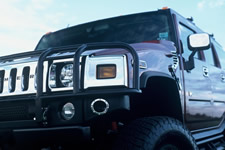|
It
is Friday night. The workweek is finally over, and, with the city behind them,
a couple of friends are driving along a dark stretch of road to the driver's family
cabin for a relaxing weekend. As the two friends chat quietly, the driver feels
the stress of the last few days beginning to ebb. She smiles a bit, thinking of
the hours of reading and talking they'll enjoy in front of the cabin's fireplace.
What she and her friend don't realize is that the pleasant weekend they had planned
is about to come to an abrupt end.
About
a mile ahead, just around a bend in the road, deer are grazing on the grass, but
soon, they'll move across the road in search of fresher greenery. In fact, they'll
be crossing the road right when the two weekenders round that bend, initiating
a disastrous turn of events.
A
recent study released by the Insurance Institute for Highway Safety indicates
that there are more the 1.5 million traffic accidents and 150 fatalities from
deer-car crashes each year. Presumably, a great many of those deer collision accidents
happen at night when visibility decreases. According to the most recent figures
from the National Highway Traffic Safety Administration, the risk of dying in
a traffic crash increases significantly when darkness falls. The fatality rate
doubles during the period of time from 9 p.m. to 6 a.m. Historically, approximately
13,000 people die in nighttime crashes every year.
Whether
it's heading out to the movies after work, coming home late, picking up dinner
or picking up the kids, many of these driving activities take place in the evening
hours when it is darker and less safe on the roads.
It's
obvious that driving at night is already tough enough without adding deer, animals,
pedestrians or even other drivers into the mix. Now, factor in poorly lit (and
sometimes poorly paved) roads in rural areas where wild animal populations are
high or in some urban areas where roads are not lit properly, and the danger is
further increased. It's almost enough to keep anyone off the roads during the
longer, darker nights of winter. However, the news isn't all gloom and doom. There
are technologies available now that can reduce the danger and increase safety
for drivers and their precious cargo - be it family and friends, or the laptop
with tomorrow's big presentation stored on it.
 |
Thermal imaging, a technology originally developed for use by the military, is finding its way into automobiles. In the automotive market, it first appeared as an option for the 2000 model Cadillac DeVille, and more recently, thermal imaging has been made available as an aftermarket accessory for the HUMMER H2 sport utility vehicles.
The automotive thermal imaging technology, created by Raytheon Infrared, is giving drivers a better chance at safety. Using thermal imaging technology that senses heat instead of light, Raytheon's NIGHTDRIVER™ system allows drivers to see up to five times farther than with their normal headlights. At 60 miles per hour, normal headlights provide only 3.5 seconds to react. But thermal imaging can offer up to 15 seconds to react to potential dangers. Drivers who have used thermal imaging have reported that they can see animals on the side of the road long before those animals try to cross it.
The system works by using an infrared camera to sense the heat energy emitted from objects in the view of the camera and produces a real-time infrared image of the scene on the head-up display (HUD). Infrared light lies between visible light and microwaves in the electromagnetic spectrum. The human eye cannot see it, but thermal infrared cameras can. Infrared energy is emitted proportionately to the temperature of an object. This means that whether an object is hotter or colder than its surroundings, it is visible with a thermal imaging camera.
Thermal cameras take the infrared energy from objects in view and translate that information into a black and white image that is projected for viewing. The warmer the objects are, the whiter they are displayed. For example, an animal preparing to cross the road at night will be visible and displayed in distinct contrast to the road and surroundings in the infrared image.
Perhaps even more valuable for the driver who spends most of her time in more urban areas is the ability of thermal imaging to help drivers see through the blinding light of the headlamps of oncoming cars. Thermal imaging is unaffected by the light, so drivers have a clear view of the road ahead. This is particularly important for older drivers, many of whom already have a difficult time seeing at night.
A virtual image is projected using a HUD within the driver's peripheral view, so, it doesn't get in the way of driving. A quick glance at the image, similar to a quick glance at the rearview mirror, provides the driver with information about objects in her path.
While the technology is only in use in a limited number of vehicles at present, virtually every U.S., European and Asian automaker is currently evaluating night vision technology. Because of the dramatic increase in safety provided by the technology, it is Raytheon Infrared's goal to see thermal imaging technology available in all new cars, just like seatbelts or air bags. To learn more about Raytheon's NIGHTDRIVER™ system, visit http://raytheonifrared.com. |